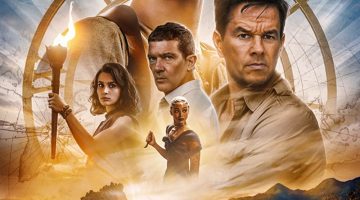Many words can be used to describe Jacques Cousteau — French inventor, explorer, film-maker and environmentalist — but he has been most remembered for pioneering society’s knowledge and vision of the ocean. The documentary Becoming Cousteau narrates the ocean of his life.
This documentary takes viewers aboard the ocean and underwater to swim and see what really goes on under the sea, floating along with the coral and fish. Cousteau unveils the phenomenon of what lies beneath and describes to the viewer exactly how going under the water is like.

The official film poster for the documentary “Becoming Cousteau”.
“It is as though you have been introduced to heaven and then forced back to Earth,” Cousteau said in the film.
He was a huge superstar, even before the age of social media, and captured a myriad of videos and pictures to showcase the underwater world most people will never see.
Although Cousteau had been a popular celebrity following his invention of the Aqualung — the technology used for scuba diving as well as for underwater cameras for video and photography — he did not care for his personal fame. Instead, he wanted the focus to be solely outside himself.
He despised the word “documentary” and dubbed his most popular film, “The Silent World”, which won an Oscar in 1957, as an adventure film.
Cousteau originally created the Aqualung with his partner Emile Gagnan to allow for people to explore the ocean together. He later utilized his work for educational purposes to help spread awareness about the urgency of protecting the ocean from pollution and caring for the environment.
He had always made films which truly showed people why they should care about the ocean. Coutseu emphasized its natural beauty through his incredibly talented cinematography and shined a light on his open and ongoing hunger for exploration.
Cousteau used his boat called the Calypso for research and exploration and lived on it with his family and crew. As he traveled the world and saw the ocean change over time, his purpose changed as well. He wasn’t always concerned with the state of the environment, but always cared for the ocean and wanted to show people why they should too.
Over time, he saw how the environment was changing and urged people to care about protecting the ocean because in doing so they were protecting the earth as a whole.
He saw the ocean begin to decay and even went to Antarctica to conduct research with his crew, witnessing insecticides as well as heavy metals and other pollution plaguing the ocean. Although it had been apparent Antarctica was the least polluted place on Earth, he saw pollution was becoming a problem there and it was hurting all of the wildlife, including the precious penguins.
As a result, the Cousteau generated urgency for Antarctica to be seen as a reserve, so it could be protected and its decline could be prevented.
Cousteau also brought awareness to the necessity of protecting coral reefs along with the other plants and animals on the ocean floor.
“For most of history, man has had to fight nature to survive; in this century he is beginning to realize that, in order to survive, he must protect it,” Cousteau said in the film.
This advocacy came at a time when there were not many people concerned about protecting the environment nor understanding the need to keep the ocean clean to prevent environmental hazards. He made sure to educate people around the world through media and traveling, informing them why they should care deeply about protecting the ocean.
Cousteau wanted to show people the ocean is connected to life on land.
This documentary captivatingly introduces a new generation to the most influential person related to environmental protection.
His innovation with the Aqualung led to mankind practically breathing underwater, which was first envisioned by Leonardo Davinci himself. This curiosity not only led to exciting water sports, but it has sincerely advanced the understanding and knowledge we have of the ocean today. Shark week probably wouldn’t even exist without this technology.
This documentary not only shines light on the importance of taking care of our oceans, but it’s basically brought to life with the wondrous footage taken by Cousteau and his crew. This film even uses footage never before seen by audiences and tells more of his story than most people had ever known before.
Watching this film is like traveling to an underwater universe, which will make audiences everywhere get the sudden impulse to buy a boat and become an oceanographer themselves.
Madison Wanco can be reached at jaedynyoung@sagebrush.unr.edu or on Twitter @NevadaSagebrush.











